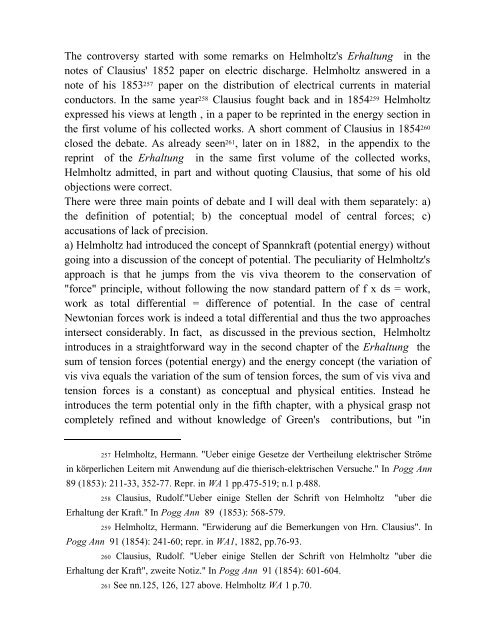Conservation and Innovation : Helmholtz's Struggle with Energy ...
Conservation and Innovation : Helmholtz's Struggle with Energy ...
Conservation and Innovation : Helmholtz's Struggle with Energy ...
Create successful ePaper yourself
Turn your PDF publications into a flip-book with our unique Google optimized e-Paper software.
The controversy started <strong>with</strong> some remarks on <strong>Helmholtz's</strong> Erhaltung in the<br />
notes of Clausius' 1852 paper on electric discharge. Helmholtz answered in a<br />
note of his 1853 257 paper on the distribution of electrical currents in material<br />
conductors. In the same year 258 Clausius fought back <strong>and</strong> in 1854 259 Helmholtz<br />
expressed his views at length , in a paper to be reprinted in the energy section in<br />
the first volume of his collected works. A short comment of Clausius in 1854 260<br />
closed the debate. As already seen 261, later on in 1882, in the appendix to the<br />
reprint of the Erhaltung in the same first volume of the collected works,<br />
Helmholtz admitted, in part <strong>and</strong> <strong>with</strong>out quoting Clausius, that some of his old<br />
objections were correct.<br />
There were three main points of debate <strong>and</strong> I will deal <strong>with</strong> them separately: a)<br />
the definition of potential; b) the conceptual model of central forces; c)<br />
accusations of lack of precision.<br />
a) Helmholtz had introduced the concept of Spannkraft (potential energy) <strong>with</strong>out<br />
going into a discussion of the concept of potential. The peculiarity of <strong>Helmholtz's</strong><br />
approach is that he jumps from the vis viva theorem to the conservation of<br />
"force" principle, <strong>with</strong>out following the now st<strong>and</strong>ard pattern of f x ds = work,<br />
work as total differential = difference of potential. In the case of central<br />
Newtonian forces work is indeed a total differential <strong>and</strong> thus the two approaches<br />
intersect considerably. In fact, as discussed in the previous section, Helmholtz<br />
introduces in a straightforward way in the second chapter of the Erhaltung the<br />
sum of tension forces (potential energy) <strong>and</strong> the energy concept (the variation of<br />
vis viva equals the variation of the sum of tension forces, the sum of vis viva <strong>and</strong><br />
tension forces is a constant) as conceptual <strong>and</strong> physical entities. Instead he<br />
introduces the term potential only in the fifth chapter, <strong>with</strong> a physical grasp not<br />
completely refined <strong>and</strong> <strong>with</strong>out knowledge of Green's contributions, but "in<br />
257 Helmholtz, Hermann. "Ueber einige Gesetze der Vertheilung elektrischer Ströme<br />
in körperlichen Leitern mit Anwendung auf die thierisch-elektrischen Versuche." In Pogg Ann<br />
89 (1853): 211-33, 352-77. Repr. in WA 1 pp.475-519; n.1 p.488.<br />
258 Clausius, Rudolf."Ueber einige Stellen der Schrift von Helmholtz "uber die<br />
Erhaltung der Kraft." In Pogg Ann 89 (1853): 568-579.<br />
259 Helmholtz, Hermann. "Erwiderung auf die Bemerkungen von Hrn. Clausius". In<br />
Pogg Ann 91 (1854): 241-60; repr. in WA1, 1882, pp.76-93.<br />
260 Clausius, Rudolf. "Ueber einige Stellen der Schrift von Helmholtz "uber die<br />
Erhaltung der Kraft", zweite Notiz." In Pogg Ann 91 (1854): 601-604.<br />
261 See nn.125, 126, 127 above. Helmholtz WA 1 p.70.
















